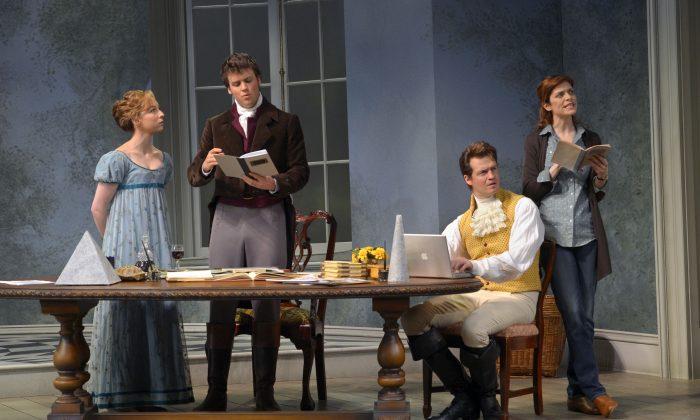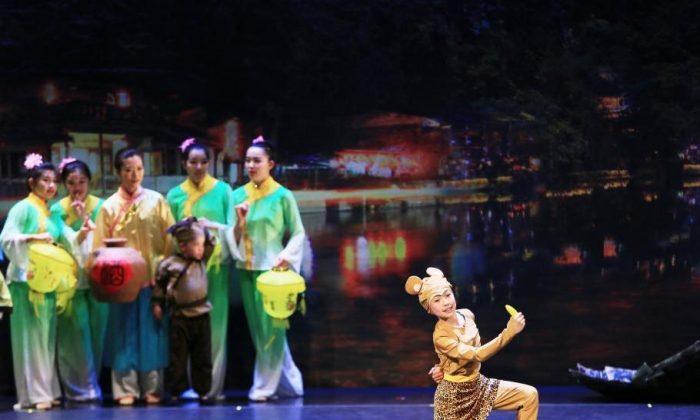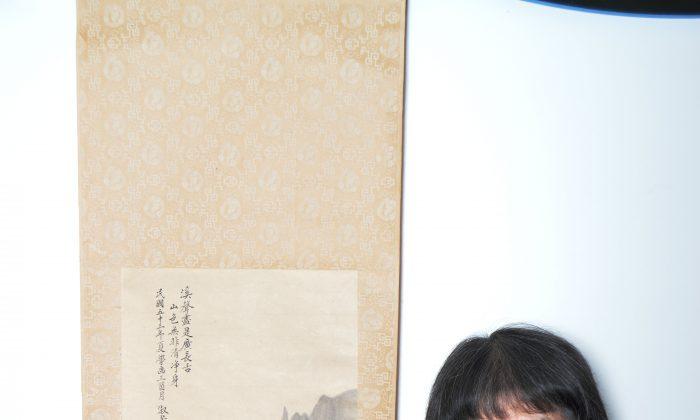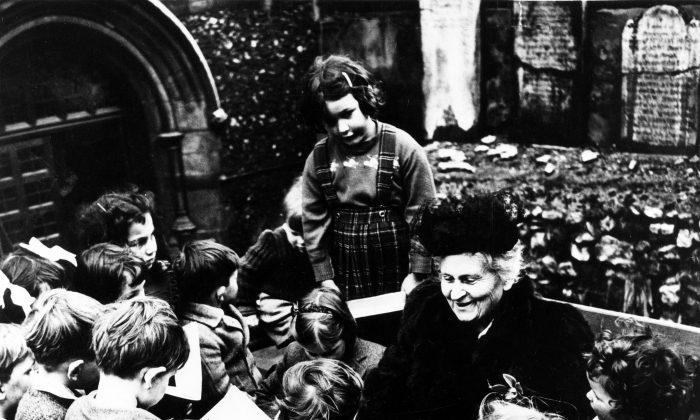SAN FRANCISCO—Tom Stoppard’s brilliant play “Arcadia,” currently brought to the stage by artistic director Carey Perloff, touches the audience’s hearts and minds. The comedy is at the prestigious Geary Theater in downtown San Francisco through June 16.
Due to damage caused by the 1989 earthquake, the American Conservatory Theater’s (A.C.T.) main-stage space was closed for the play’s West Coast premiere in 1995. Perloff had to bring it to a smaller theater’s stage. Finally, Stoppard’s masterpiece is staring at A.C.T.’s majestic Geary Theater.
In a carefully arranged plot, “Arcadia” juxtaposes the romantic era of the famous British poet Lord Byron with that of 20th-century researchers, who try to understand Byron’s time from books, notes, letters, and diagrams.
Unfolding the Play
Details from different time periods first appear unpredictably scattered and then, during the course of the play, start to show an obviously predetermined pattern. In Scene 1 Thomasina Coverly, an ingenious young lady, learns from her private tutor Septimus Hodge in 1809 about the Last Theorem by 17th-century French lawyer and amateur mathematician Pierre de Fermat.
In Scene 2, the ambitious literature professor Bernard Nightingale visits bestselling writer Hannah Jarvis. They both work on Byron—he for a lecture, she for her next book.
In Scene 3, Thomasina has a Latin lesson and grieves over the hundreds of plays and thousands of poems from the ancient Greek era that were lost in the fire of the Alexandrian Library in Egypt.
Artistic director Perloff, who celebrates her 20th anniversary at A.C.T. this year, sees loss as “a big theme running through the play” and recalled “that beautiful scene when Thomasina says to Septimus: ‘How can we sleep for grief?’ and he says that nothing is really lost and is written again in another language or another time. It’s a really interesting question, you know, personal loss and cultural loss over time.”
And Perloff added, regarding Thomasina that “this beautiful little girl is going to die in a fire and that’s the flame of her passion.”
Still in her Latin class, Thomasina takes notes about her mathematical discoveries on the margin of her math primer, imitating Fermat, whose Last Theorem was found on the margin of an ancient Greek book and was proved only in the 1990s.
Thomasina’s note about her “truly wonderful method” is picked up in Scene 4 by Hannah and reviewed by the mathematical biologist Valentine Coverly, who regards himself as Hannah’s fiancé.
Valentine recognizes the mathematical significance of Thomasina’s note, which goes far beyond her time. He says about her calculations, “The unpredictable and the predetermined unfold together to make everything the way it is,” alluding to “The Fractal Geometry of Nature” about chaos and order, published in 1982 by the Franco-American mathematician Benoît Mandelbrot.
Mandelbrot’s geometry, based on iterated algorithms, creates patterns out of unpredictably dotted points. It describes “the things people write poetry about—clouds—daffodils—waterfalls,” as Valentine puts it. Only recently has the theory become well-known.
Perloff said: “San Francisco is so full of technology people who know what an iterated algorism is. Last time we did it, they didn’t really get the science part, and now I feel they really get the science.”
Deeper Meaning
The acts and relations of the characters from the past fit in with the historical facts about Lord Byron and his affairs. They appear in a way they could have really happened.
Steeped in somewhat silly jokes, however, the many dialogues in the past and the present raise deeper questions such as what is reality, and how should we describe it—in the words of the poet or in the words of the scientist? What is the truth, and how do we construct it from the pieces we know? What brings opposing aspects together, and what is human life about?
Stoppard’s early life seems rife with fateful events. Born in Czechoslovakia in 1937, his family took him to live in Singapore at the age 2. In 1942, his mother left with him and his brother for India. His father stayed behind and was killed during the Japanese invasion.
In 1946, he left for England where he felt he had found a home. His plays were rejected by the Royal Shakespeare Company and the Royal Court, but nonetheless became successful and award winning. “Arcadia” won the 1994–1995 the Olivier Award and the New York Drama Critics’ Circle Award.
Scene 7 brings both groups of characters together on stage at the same time, as if reflecting that there is only one reality. The two groups are still not able to communicate directly with each other, but there are direct relations, as if one character is reflected by another.
While in Scene 5, the present-day researcher Bernard is convinced of the truth of his interpretation of what happened in 1809; we learn in Scene 6 whether he was right. Only in Scene 7 does he himself learn whether he was right.
While previously opposing ideals or entities, such as classic versus romantic, romantic versus realist, poet versus scientist, determinist versus defender of free will, got more and more separated from each other through the course of the play, Scene 7 brings them together.
When writer Hannah, who seeks the classic ideal, sees Valentine’s computer generation of Thomasina’s equations, she suddenly says, “How beautiful!” In this moment of recognizing and appreciating beauty, the boundary between their different worldviews is suddenly dissolved, and beauty is restored as a means to go beyond what separates.
The Production
Perloff’s production is lighthearted, mature, and harmonious. The person sitting next to me said simply, “Lovely.”
Leaving the full house production that received a hearty, though short standing ovation, I felt uplifted and a bit as if in “Arcadia,” heaven for the ancient Greeks.
The script requires that “the upstage wall is mainly tall, shapely, [with] uncurtained windows, one or more of which work as doors.” Perloff’s upstage wall is beautifully painted with trees, illustrating classic aesthetics as well as fractal geometry.
Perloff said that because of the much bigger stage as compared to 1995, she had to redesign the set, “So this time I decided we would paint a beautiful imaginary garden on the wall of the set, which is very lovely, and I think this gives the garden a much bigger theme than before.”
Craig Martyn, history teacher from San José, Calif., came with his wife Ann. He said, “We love the play. We saw it 20 years ago here. We couldn’t wait to come back.”
Elaborating on the difference to the 1995 performance, he said: “The cast, different theater, the staging. The background was good. We liked the background, the set. You could see the trees, the complexity of the trees.”
When asked what was most fascinating about the play, he said, “Romance and mathematics. The different scientific points, juxtaposed with the romance and all the coincidences—the stories merging together, past and present, math and love.”
Eva Ramos, audience service representative at the nonprofit A.C.T., said: “Our patrons are subscribers who love Stoppard.” She also remembers the 1995 production, “This was a special season when our subscribers came back after we had been earthquaked out.”
Then she said, expressing her personal passion for the piece: “It is just a beautiful play, the language, it flows in and out, and it’s just been a favorite piece for everybody for so long.”
[i]
“Arcadia,” by Tom Stoppard, is at the A.C.T. Geary Theater in San Francisco through June 16.[/i]






Friends Read Free